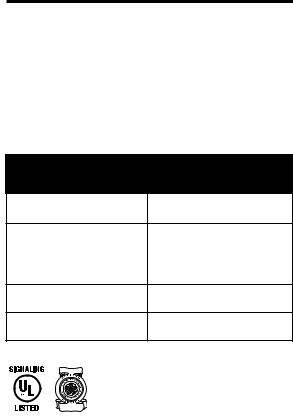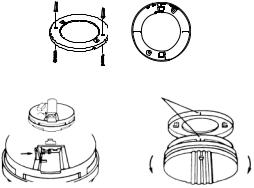Kidde 0915 User Manual [en, es]

0915 |
For model: 0915 |
|
|
|
|
|
|
Smoke Alarm User’s Guide
9 Volt Battery Operated Smoke Alarm
Thank you for purchasing this smoke alarm. It is an important part of your family’s home safety plan. You can trust this product to provide the highest quality safety protection. We know you expect nothing less when the lives of your family are at stake.
For your convenience, write down the following information. If you call our Consumer Hotline, these are the first questions you will be asked.
Smoke Alarm Model Number (located on back of alarm):
Date Code (located on back of alarm): The National Fire Protection Association (NFPA) and the manufacturer recommend replacing this alarm
ten years from the date code.
Date of Purchase:
Where Purchased:
820-0897 REV. B 11/2006
This alarm detects products of combustion using the ionization technique. It contains 0.9 microcurie of Americium 241, a radioactive material (see Section 9). Distributed under U.S. NRC License No. 32-23858-01E. Manufactured in compliance with U.S. NRC safety criteria in 10 CFR 32.27. The purchaser is exempt from any regulatory requirements. Do not try to repair the smoke alarm yourself. Refer to the instructions in Section 12 for service.
WARNING! BATTERY DOOR WILL NOT CLOSE UNLESS BATTERY IS PRESENT. REMOVAL OF BATTERY WILL RENDER THE SMOKE ALARM INOPERATIVE.
IMPORTANT! READ ALL INSTRUCTIONS BEFORE INSTALLATION AND KEEP THIS MANUAL NEAR THE ALARM FOR FUTURE REFERENCE.
CONTENTS OF THIS MANUAL
1 -- RECOMMENDED LOCATIONS FOR SMOKE ALARMS
2 -- LOCATIONS TO AVOID
3 -- INSTALLATION INSTRUCTIONS
4 -- OPERATION AND TESTING
5 -- NUISANCE ALARMS
6 -- MAINTENANCE
7 -- LIMITATIONS OF SMOKE ALARMS
8 -- GOOD SAFETY HABITS
9 -- NRC INFORMATION
10 -- NFPA PROTECTION STANDARD 72
11 -- CALIFORNIA STATE FIRE MARSHAL REQUIRED INFORMATION
12 -- SERVICE AND WARRANTY
1.RECOMMENDED LOCATIONS FOR ALARMS
•Locate the first alarm in the immediate area of the bedrooms. Try to monitor the exit path as the bedrooms are usually farthest from the exit. If more than one sleeping area exists, locate additional alarms in each sleeping area.
•Locate additional alarms to monitor any stairway as stairways act like chimneys for smoke and heat.
•Locate at least one alarm on every floor level.
•Locate an alarm in every bedroom.

•Locate an alarm in every room where electrical appliances are operated (i.e. portable heaters or humidifiers).
•Locate an alarm in every room where someone sleeps with the door closed. The closed door may prevent an alarm not located in that room from waking the sleeper.
•Smoke, heat, and combustion products rise to the ceiling and spread horizontally. Mounting the smoke alarm on the ceiling in the center of the room places it closest to all points in the room. Ceiling mounting is preferred in ordinary residential construction.
•For mobile home installation, select locations carefully to avoid thermal barriers that may form at the ceiling. For more details, see MOBILE HOME INSTALLATION below.
•When mounting an alarm on the ceiling, locate it at a minimum of 4” (10cm) from the side wall (see Figure 1).
•When mounting the alarm on the wall, use an inside wall with the top edge of the alarm at a minimum of 4” (10cm) and a maximum of 12” (30.5cm) below the ceiling. (see Figure 1).
FIGURE 1 |
FIGURE 2 |
FIGURE 3 |
•Put smoke alarms at both ends of a bedroom hallway or large room if the hallway or room is more than 30 feet (9.1 m) long.
•Install Smoke Alarms on sloped, peaked or cathedral ceilings at or within 3ft (0.9m)of the highest point (measured horizontally). NFPA 72 states: “Smoke alarms in rooms with ceiling slopes greater than 1 foot in 8 feet (.3m in 2.4m) horizontally shall be located on the high side of the room.” NFPA 72 states: “A row of alarms shall be spaced and located within 3 ft (0.9m) of the peak of the ceiling measured horizontally” (see Figure 3).
MOBILE HOME INSTALLATION
Modern mobile homes have been designed and built to be energy efficient. Install smoke alarms as recommended above (refer to RECOMMENDED LOCATIONS and Figures 1 and 2).
In older mobile homes that are not well insulated compared to present standards, extreme heat or cold can be transferred from the outside to the inside through poorly insulated walls and roof. This may create a thermal barrier which can prevent the smoke from reaching an alarm mounted on the ceiling. In such units, install the smoke alarm on an inside wall with the top edge of the alarm at a minimum of 4” (10cm) and a maximum of 12” (30.5cm) below the ceiling (see Figure 1).
If you are not sure about the insulation in your mobile home, or if you notice that the outer walls and ceiling are either hot or cold, install the alarm on an inside wall. For minimum protection, install at least one alarm close to the bedrooms. For additional protection, see SINGLE FLOOR PLAN in Figure 2.
WARNING: TEST YOUR SMOKE ALARM OPERATION AFTER R.V. OR MOBILE HOME VEHICLE HAS BEEN IN STORAGE, BEFORE EACH TRIP AND AT LEAST ONCE A WEEK DURING USE.
2. LOCATIONS TO AVOID
•In the garage. Products of combustion are present when you start your automobile.
•Less than 4” (10cm) from the peak of an “A” frame type ceiling.
•In an area where the temperature may fall below 40ºF or rise above 100ºF, such as garages and unfinished attics.
•In dusty areas. Dust particles may cause nuisance alarm or failure to alarm.

•In very humid areas. Moisture or steam can cause nuisance alarms.
•In insect-infested areas.
•Smoke alarms should not be installed within 3 ft (.9m) of the following: the door to a kitchen, the door to a bathroom containing a tub or shower, forced air supply ducts used for heating or cooling, ceiling or whole house ventilating fans, or other high air flow areas.
•Kitchens. Normal cooking may cause nuisance alarms. If a kitchen alarm is desired, it should have an alarm silence feature or be a photoelectric type.
•Near fluorescent lights. Electronic “noise” may cause nuisance alarms.
•Smoke alarms are not to be used with detector guards unless the combination (alarm and guard) has been evaluated and found suitable for that purpose.
3. INSTALLATION INSTRUCTIONS
CAUTION: THIS UNIT IS SEALED. THE COVER IS NOT REMOVABLE!
When |
|
|
When wall |
mounting in |
|
|
mounting, the |
a hallway, |
|
|
“A” line should |
the “A” line |
A |
A |
be horizontal |
should be |
|
|
and the “UP FOR |
parallel with |
|
|
WALL MOUNT- |
the hallway. |
|
|
ING” arrow must |
FIGURE 4 |
FIGURE 5 |
|
be pointing up. |
|
Alignment |
|
|
|
Marks |
|
|
Install |
Remove |
FIGURE 6 |
FIGURE 7 |

1.Remove the mounting plate from the back of the alarm by holding the mounting plate and twisting the alarm in the direction indicated by the “OFF” arrow on the alarm cover.
2.To insure aesthetic alignment of the alarm with the hallway or wall, the “A” line on the mounting plate should be parallel with the hallway when ceiling mounting or horizontal when wall mounting.
3.After selecting the proper smoke alarm location as described in Section 1, attach the mounting plate to the ceiling as shown in Figure 4. For wall mounting see Figure 5. Place mounting plate on the wall. Be sure the “UP FOR WALL MOUNTING “ text and arrow are facing up. Use the screws and anchors provided to secure the mounting plate (use 3/16” drill bit for anchor holes).
4.Battery installation instructions are provided on the inside of the battery door. To ensure proper installation of the smoke alarm battery, follow the instructions.
5.When installing the battery, press the battery reminder finger down into the battery compartment and install the battery (see Figure 6).
CAUTION! IF THE BATTERY REMINDER FINGER IS NOT HELD DOWN IN THE BATTERY COMPARTMENT BY THE BATTERY, THE BATTERY DOOR WILL NOT CLOSE AND THE UNIT WILL NOT ATTACH TO THE MOUNTING BRACKET.
6.Alignment marks are provided on the edge of the trim plate and the alarm. After installing the mounting plate, place the alarm on the mounting plate with the alignment marks lined up. Twist the alarm in the direction indicated by the “ON” arrow on the alarm cover (see Figure 7) until it locks in place.
7.USING TAMPER RESIST LOCKING PIN: To make your smoke alarm tamper resistant, a locking pin has been provided in the bag with the screws and anchors. Using this pin will help deter children and others
from removing the alarm from the |
FIGURE 8 |
Tamper Resist |
|
mounting plate. To use the pin, |
|||
|
Locking Pin |
||
insert it into the hole in the side of |
|
|
the alarm after the alarm has been installed on the mounting plate (see Figure 8).
NOTE: THE TAMPER RESIST PIN WILL HAVE TO BE REMOVED IN ORDER TO CHANGE THE BATTERIES. USE LONG NOSE PLIERS TO PULL THE PIN OUT OF THE HOLE. IT IS NOW POSSIBLE TO REMOVE THE ALARM FROM THE MOUNTING PLATE.
8.After installation, test your alarm by depressing and holding down the test button for at least 5 seconds. This should sound the alarm.
4. OPERATION AND TESTING
OPERATION: The smoke alarm is operating once a fresh battery is installed and testing is complete. When products of combustion are sensed, the unit sounds a loud 85db pulsating alarm until the air is cleared.
FLASHING LED LIGHT: This smoke alarm is equipped with a flashing red indicator light. The light is located under the test button and will flash every 30 - 40 seconds to indicate that the smoke alarm is receiving power.
TESTING: Test by pushing the test button on the cover and holding it down for a minimum of 5 seconds. This will sound the alarm if the electronic circuitry, horn, and battery are working. If no alarm sounds, the unit has defective batteries or other failure. DO NOT use an open flame to test your alarm, you could damage the alarm or ignite combustible materials and start a structure fire.
TEST THE ALARM WEEKLY TO ENSURE PROPER OPERATION. Erratic or low sound coming from your alarm may indicate a defective alarm, and it should be returned for service (see Section 12).
NOTE: WEEKLY TESTING IS REQUIRED.
5. NUISANCE ALARMS
Smoke alarms are designed to minimize nuisance alarms. Cigarette smoke will not normally set off the alarm, unless the smoke is blown directly into the alarm. Combustion particles from cooking may set off the alarm if the alarm is located close to the cooking area. Large quantities of combustible particles are generated from spills or when broiling. Using the fan on a range hood which vents to the outside (non-recirculating type) will also help remove these combustible products from the kitchen.
If the alarm does sound, check for fires first. If a fire is discovered, get out and call the fire department. If no fire is present, check to see if one of the reasons listed in Section 2 may have caused the alarm.
